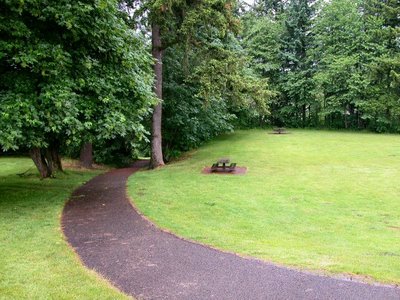
Date visited: March 16, 2007, last update: August 1, 2007
Agency: Vancouver-Clark Parks & Recreation
Path Surface: Some asphalt, mostly gravel
Elevation gain/loss: 15 feet
Distance: 3.3 miles one way
Ratings: Setting +++ Calorie-burning +++
Directions: The trailhead we used is off NW Lake Rd in Camas. One way to get there is to take the 192nd exit from SR 14 to SE 1st St where you will turn right. 1st St turns into NW Lake Lake Rd. Near the bottom of a hill, look for the driveway to the boat launch. The path follows the west shore of the lake.
Every time we have been in this area, we have gone to Lacamas Lake Park without ever realizing that this very nice trail was so nearby. On a sunny early-spring day, if it is just a bit cool for the shade of Lacamas Lake Park, give this path a try. Or on a hot summer day, the shade of the deciduous trees is a nice break from the heat.
The path begins over asphalt across the driveway from the restrooms. Feeders at the small home to the left of the path attract juncos, chickadees, towhees and song sparrows, to name a few. In the past, the path appears to have been surrounded by blackberry bushes, but much work has been done to eliminate the nuisance.
After ¼ mile, the path changes to gravel, but strollers and bikes will do fine. On Lacamas Lake in the spring, you might spot scaup, gadwall, pied-bill grebes, American widgeon, bufflehead, double-crested cormorants and geese. You might also stroll down to the shore to see the hundreds of water snail shells, the remains of the meals of many mallards. Salmonberries, Indian Plum (
Oemleria cerasiformus) and flowering trees are in bloom as are a few other early wildflowers. Wildflowers continue to bloom into August, including the orange
Impatiens capensis.
After about 1.4 miles, you arrive at a boat launch where you must turn left uphill to rejoin the path. Before you do, take a look across the lake to the bright red Leadbetter Mansion.
The surroundings from here have a considerably less wild feel, but if you like to gawk at some gorgeous houses, you are in luck. A few more spots along the way yield some surprising sights. During our spring visit, we saw a large flock of gulls, a mixture of mew, California and ring bills. From one of the bridges, we spotted a great mass of rough-skinned newts in the water. Summer birds may include kingfishers, osprey, goldfinches (especially near the blooming thistle), white crowned sparrows, willow flycatchers and western wood peewees. On a hot, early August day, we saw one patient heron stalking through the marshy area toward the north end of the lake.
After 3.3 miles, the path ends in another parking lot. If you didn't notice before, sunny days yield a great Mt. Hood view on the return trip. Other wildlife we spotted included a garter snake, black and orange caterpillars, red breasted nuthatch, yellow-rumped warblers, winter wren, stellars jays, flickers, a kingfisher, red tail hawk, bushtits, gold-crowned kinglets, house sparrows, robins and signs of beavers. Go see what you can find!
Map.
















.2.jpg)


